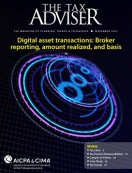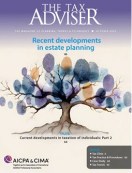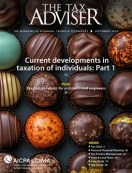- column
- CASE STUDY
Transactions between related parties
Related
IRS clarifies health savings account changes in H.R. 1 in new notice
PTEs need more notice of changes, more time to respond, AICPA says
IRS announces prop. regs. on international tax law provisions in OBBBA
Various provisions have been enacted to prevent abuses in transactions involving related parties. A practitioner applying one of these sets of rules should be careful to understand exactly how “related party” and “taxpayer” are defined for that particular set of rules. The definitions can vary among the different Code sections and are sometimes determined by reference to another section of the Code. For most purposes, shareholders owning an interest in a closely held corporation are considered related to it. However, the percentage of ownership required to meet the definition of a related party may vary.
Some of the related–party provisions apply only if the “prohibited” relationship exists immediately before and after the transaction. Others apply if the parties are related at any time during the tax year of the transaction. Therefore, changes in relationships must be considered when planning transactions.
Installment sales
All gains on an installment sale of depreciable property between certain related parties must be recognized in the year of the sale (Sec. 453(g)). This rule does not apply if it can be established that the disposition did not have as one of its principal purposes the avoidance of income tax. Furthermore, sales between related individuals (e.g., parent and child) are not subject to this rule, so the installment method can be used for such sales (except for gain subject to ordinary–income recapture).
If property is sold on the installment method to a related person (as defined in Sec. 453(f)) and that related person disposes of the property within two years of the sale, the previously unrecognized installment gain of the seller must be recognized in the year of such disposition (Sec. 453(e)(1)). For this purpose, a related party generally includes a spouse; child; grandchild; parent; brother; sister; or a related corporation, partnership, estate, or trust.
The Tax Court has held that the liquidation of a related corporation within the two–year period is considered a disposition. In addition, when substantially all of the related corporation’s assets were sold for cash prior to the end of the two–year period but the actual liquidation occurred after two years, the court held the disposition for purposes of the installment sale rules occurred on the date the corporate assets were sold, rather than when the corporation liquidated (Shelton, 105 T.C. 114 (1995)). Thus, the corporation was required to recognize the remaining installment gain.
PSCs formed or availed of to avoid or evade income tax: Sec. 269A
Due to the IRS’s limited success in applying Sec. 482 and Sec. 269 to personal service corporations (PSCs), Sec. 269A was enacted. This provision effectively overturned case law under Sec. 482 after the IRS was unsuccessful in reallocating income where PSCs served no meaningful business purpose other than to secure tax benefits that were not otherwise available. Sec. 269A applies the broad authority of Sec. 482 and Sec. 269 to a very specific entity: a PSC performing services for one entity.
Sec. 269A applies if (1) substantially all of a PSC’s services are performed for (or on behalf of) one other corporation, partnership, or other entity, and (2) the principal purpose for using the PSC is avoiding or evading federal income taxes by reducing the income of, or securing the benefit of any expense, deduction, credit, exclusion, or other allowance for, any employee–owner that is not otherwise available (Sec. 269A(a)).
If the above factors exist, the IRS has the authority to allocate all income, deductions, credits, exclusions, and other allowances between such PSC and its employee–owners, if such an allocation is necessary to prevent avoidance or evasion of federal income tax or to clearly reflect the income of the PSC or any of its employee–owners (Sec. 269A(a)). This is substantially the same authority granted to the IRS under Sec. 482.
Some guidance has been provided as to when a PSC is deemed to have been formed or availed of for the principal purpose of avoiding or evading federal income taxes (Prop. Regs. Sec. 1.269A–1). The requisite principal purpose is evidenced when use of the corporation either reduces the income of any employee–owner or secures for any employee–owner one or more tax benefits that would not otherwise be available (Prop. Regs. Sec. 1.269A–1(a)(2)).
For these purposes, the term “tax benefits” includes but is not limited to: (1) the dividends–received deduction; (2) deferral of an employee–owner’s income through the use of a corporation with a fiscal year or accounting method differing from that of the employee–owner; (3) group–term life insurance; and (4) certain accident and health plans (Prop. Regs. Sec. 1.269A–1(b)(6)). Contributions to, and benefits under, qualified employer plans generally are not taken into account in determining the presence or absence of a principal purpose of the PSC (Prop. Regs. Secs. 1.269A–1(b)(6) and (d)).
Safe harbor: A safe harbor is provided for situations in which the tax benefits obtained by formation of the corporation are small. A corporation is deemed not to have been formed or availed of for the principal purpose of avoiding or evading federal income taxes if no employee–owner’s federal tax liability is reduced in a 12–month period by more than the lesser of (1) $2,500 or (2) 10% of the federal income tax liability of the employee–owner that would have resulted in the 12–month period had the employee–owner performed the personal services in an individual capacity (Prop. Regs. Sec. 1.269A–1(c)).
Definitions relating to Sec. 269A
For purposes of Sec. 269A, a PSC is defined as a corporation the principal activity of which is the performance of personal services that are substantially performed by employee–owners (Sec. 269A(b)(1); Prop. Regs. Sec. 1.269A–1(b)(1)).
Principal activity: The term “principal activity” is not defined in either Sec. 269A or its proposed regulation. Although this term is defined in Regs. Sec. 1.441–3(e), there is no reference to these regulations by either Sec. 269A or its proposed regulation.
Substantially performed: The term “substantially performed” is not defined in either Sec. 269A or its proposed regulation. Although this term is defined in Regs. Sec. 1.441–3(f), there is no reference to these regulations by either Sec. 269A or its proposed regulation.
Personal services: Neither Sec. 269A nor its proposed regulation contains any definition or list of personal services. Although this term is defined in the regulations relating to Sec. 448 (see Regs. Sec. 1.441–3(d)), there is no reference to these regulations by either Sec. 269A or its proposed regulation.
Employee–owner: An employee–owner is any employee who owns, on any day during the tax year, more than 10% of the PSC’s outstanding stock. In determining how much stock an employee owns, the attribution rules under Sec. 318 apply, except that these rules are modified to require ownership attribution from a corporation when only 5% or more of the corporation’s stock is owned (Sec. 269A(b)(2); Prop. Regs. Sec. 1.269A–1(b)(2)). The employee is treated as owning stock owned by various related parties, including spouses, children, grandchildren, parents, partnerships, corporations, estates, and trusts (Sec. 318).
Substantially all: Sec. 269A applies if substantially all of a PSC’s services are performed for (or on behalf of) one other corporation, partnership, or other entity. The term “substantially all” is not defined in either Sec. 269A or its proposed regulation. Although this term is defined in the regulations under Sec. 448 (see Temp. Regs. Sec. 1.448–1T(e)(4)), there is no reference to these regulations by either Sec. 269A or its proposed regulation.
Entity: The term “entity” means a corporation, partnership, or other entity. All persons related to such entity are treated as one entity (Sec. 269A(b)(3); Prop. Regs. Sec. 1.269A–1(b)(3)). Related persons include brothers and sisters, spouses, ancestors, lineal descendants, and related corporations, trusts, estates, partnerships, and controlled groups under Sec. 1563(a) (except that more than 50% is substituted for at least 80% in determining control) (see Secs. 144(a)(3), 267(b), and 707(b)). Note that the relationships here are different than the relationships specified in determining attribution of ownership for employee–owners.
Examples relating to Sec. 269A
The following examples illustrate whether a corporation is a PSC for purposes of Sec. 269A.
Example 1. When a corporation is not a PSC under Sec. 269A: CPA is a C corporation with more than 500 clients. Two accountants, who own 100% of CPA’s stock, provide services as employees of the corporation. Approximately 50% of the services are provided by the owners, with the balance provided by unrelated nonowner employees. All employees of CPA spend their time performing accounting services. All compensation costs are attributable to the performance of services, and 80% of the compensation cost is attributable to the two owners. All of CPA’s gross income is received for accounting or related services provided. CPA is not a PSC for purposes of Sec. 269A because CPA provides services to many clients.
Example 2. When a corporation is not a PSC due to the sports exclusion: R is a C corporation. A hockey player is the sole shareholder and employee of R. The player contracts with R to provide services as specified by R. R contracts with a hockey club to provide the player’s services to the club. The player created R for increased bargaining power and the possibility of placing money into a pension plan. All of R’s gross income is received for the services provided to the club by the player. All compensation costs are attributable to the employee–owner for his services as a hockey player. All the time spent by the employee–owner in his capacity as an employee is as a hockey player.
In this situation, it appears that R is a PSC for purposes of Sec. 269A because one employee–owner owns more than 10% of the stock, and services are provided for only one client. However, there is no evidence of the requisite tax–avoidance or –evasion motive. The desire for a pension plan is not a tax–avoidance motive (Prop. Regs. Sec. 1.269A–1(d)(1)). In addition, the scope of services covered under this section has not been defined. Sports have been expressly excluded from the definition of services under Sec. 448 (Temp. Regs. Sec. 1.448–1T(e)(4)(iii)). Even if R were considered a PSC, income could not be reallocated because of the lack of a tax–avoidance motive (see Sec. 269A(a)).
Note: Final regulations state that the rules set forth in Regs. Sec. 1.448–1 and Temp. Regs. Sec. 1.448–1T apply to tax years beginning before Jan. 1, 2018 (Regs. Sec. 1.448–2(a)(1)). However, the rules in Temp. Regs. Sec. 1.448–1T(e) (discussed above), relating to the exception for qualified PSCs, continue to apply for tax years beginning after Dec. 31, 2017 (Regs. Sec. 1.448–2(e)). Regs. Sec. 1.448–2 provides the rules relating to the limitation on the use of the cash–receipts–and–disbursements method of accounting (cash method) by certain taxpayers applicable to tax years beginning after Dec. 31, 2017 (Regs. Sec. 1.448–2(a)(1)).
Contributor
Shannon Christensen, J.D., MBT, is an executive editor with Thomson Reuters Checkpoint. For more information about this column, contact thetaxadviser@aicpa.org. This case study has been adapted from Checkpoint Tax Planning and Advisory Guide‘s C Corporations topic. Published by Thomson Reuters, Frisco, Texas, 2025 (800-431-9025; tax.thomsonreuters.com).














